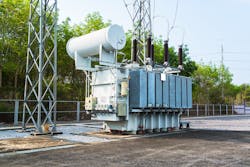Article 450, Part III provides the requirements for transformer vaults. The first requirement is that they be located where they can be ventilated to the outside without using flues or ducts, wherever such an arrangement is practicable [Sec. 450.41].
The walls and roofs of vaults must have the necessary mechanical strength for the conditions and must also have a minimum 3 hr of fire resistance [Sec. 450.42]. Studs and wallboard construction are not permitted. If the floor is in contact with the earth, it must be of concrete at least 4-in. thick. If it’s above a vacant space or there are other stories below it, the floor must have approved structural strength for the load imposed on it and also have a 3-hr fire resistance. Informational Note 2 informs us that a typical 3-hr fire construction is 6 in. of reinforced concrete. The use of automatic sprinklers reduces the minimum fire resistance to a 1-hr rating [Sec. 450.42 Exception].
As with the walls, the doors to vaults must have a 3-hr fire resistance [Sec. 450.43(A)]. They must also be tight-fitting. The door must have a sill or curb that is at least 4-in. tall and that will confine oil from the largest transformer contained therein [Sec. 450.43(B)].
What exits a vault via ventilation must be assumed to be at least slightly hazardous because it’s at an elevated temperature and it may contain oil fumes. For this reason (and the possibility of an arc blast), ventilation openings must be kept as far as possible from doors, windows, fire escapes, and combustible material [Sec. 450.45(A)]. The vents must also have automatically closing fire dampers [Sec. 450.45(E)].
Where practicable, provide a floor drain to any vault containing more than 100kVA of transformer capacity [Sec. 450.46]. No pipe or duct system foreign to the electrical installation can enter the vault [Sec. 450.47], and no materials may be stored in a transformer vault [Sec. 450.48].
In an existing facility, the issue of materials storage in a vault may become a political power struggle. At a Tennessee appliance factory, administrative managers insisted on storing file boxes and spare fluorescent lamps in various equipment closets and one large transformer vault. They outranked the electrical maintenance manager (EMM) on the org chart and made him aware of this when he tried to dissuade them from misusing these spaces. So he took his boss, the plant engineer (an industrial engineer), on a quick tour. Upon entering the transformer vault, the plant engineer was astounded at the sight. He immediately ordered maintenance to rekey the locks, and keys were not to be issued to anyone outside of the engineering and maintenance departments. He then informed the plant manager of the problem and its possible consequences (including big problems with the insurance company) and his solution. Since the plant manager was the highest ranking person on site, violators had to deal with him instead of the EMM. It created a different dynamic there, and compliance ensued without much ado.
Another factor to consider with transformer vaults is many of them are uncomfortable, difficult to enter/exit, and (due to the passive ventilation) possibly unsafe to breathe in. Such vaults are nearly always considered confined entry rooms, and a confined entry permit process needs to be followed. Temporary forced ventilation via fans and ducts may be required to reduce the temperature, and/or increase the oxygen levels, and/or ventilate out vapors or gases that have accumulated therein. Extraction gear and an attendant may also be required. Scope it out before even thinking about going in.
About the Author

Mark Lamendola
Mark is an expert in maintenance management, having racked up an impressive track record during his time working in the field. He also has extensive knowledge of, and practical expertise with, the National Electrical Code (NEC). Through his consulting business, he provides articles and training materials on electrical topics, specializing in making difficult subjects easy to understand and focusing on the practical aspects of electrical work.
Prior to starting his own business, Mark served as the Technical Editor on EC&M for six years, worked three years in nuclear maintenance, six years as a contract project engineer/project manager, three years as a systems engineer, and three years in plant maintenance management.
Mark earned an AAS degree from Rock Valley College, a BSEET from Columbia Pacific University, and an MBA from Lake Erie College. He’s also completed several related certifications over the years and even was formerly licensed as a Master Electrician. He is a Senior Member of the IEEE and past Chairman of the Kansas City Chapters of both the IEEE and the IEEE Computer Society. Mark also served as the program director for, a board member of, and webmaster of, the Midwest Chapter of the 7x24 Exchange. He has also held memberships with the following organizations: NETA, NFPA, International Association of Webmasters, and Institute of Certified Professional Managers.
